|
Chorale Melodies used in Bach's Vocal Works
Aus tiefer Not schrei ich zu dir (I)
Aus tiefer Not schrei ich zu dir (II)
|
|
Melodies & Texts | Use of the CM's by Bach | Use of the CM's by other composers |
| |
|
Melodies & Texts: Zahn: | EKG: |
|
Text:
Aus tiefer Not schrei ich zu dir (Psalm 130) |
|
Martin Luther wrote various types of chorales and often partially composed them (in addition to preparing the verse form and writing a number of verses to fit the desired format, he also gave his input into the shape of the melody as well while a composer such as Johann Walter then helped to put Luther’s musical suggestions into their final form). Those based upon the Psalm texts are: Ach Gott, vom Himmel sieh darein (Psalm 12), Es spricht der Unweisen Mund wohl (Psalm 14), Ein feste Burg ist unser Gott (Psalm 46), Es wolle Gott uns gnädig sein (Psalm 67), Wär Gott nicht mit uns diese Zeit (Psalm 124), Wohl dem, der in Gottes Furcht steht (Psalm 128), Aus tiefer Not schrei ich zu dir (Psalm 130).
There are two different melodies associated with this text: Aus tiefer Not schrei ich zu dir (I) (Zahn: 4437) and Aus tiefer Not schrei ich zu dir (II) (Zahn: 4438). The EKG gives both melodies (I & II) separately, but listed under the same number (EKG: 195). |
| |
|
Melody 1: Aus tiefer Not schrei ich zu dir (I) | Zahn: 4437 | EKG: 195 |
|
This melody is attributed to Martin Luther (with the qualification indicated above) and first appeared in: Geystliche Gesangk Buchleyn (edited by Johann Walter), Wittenberg, 1524.
Following a precedent set by the Bohemian Brethren of printing collections of congregational hymns in the vernacular, and after a number of chorales had appeared in single broadsheets, four significant collections of German chorales appeared within a single year. Their interrelationships shed light on the procedures of the early hymn writers. The so-called Achtliederbuch (Etlich Cristlich Lider), evidently the earliest, was printed in Nuremberg in 1523/4 (despite the imprint ‘Wittenberg./M.D.Xiiij’ on the title-page). It included eight chorale texts and a total of four different melodies. It was followed in 1524 by two publications, both called Eyn Enchiridion oder Handbüchlein and known as the Erfurter Enchiridien, containing a total of 25 hymns and 16 melodies. Luther’s Aus tiefer Not and Ach Gott vom Himmel appeared here for the first time with their melodies; the texts alone had been printed in the Achtliederbuch with a direction that they were to be sung, along with Es spricht der Unweisen Mund wohl, to the melody now reserved for Speratus’s Es ist das Heil uns kommen her...
A modal aesthetic in many of Luther’s chorales – the use of Ionian mode for hymns of faith, of Dorian or Hypodorian for meditative texts and of Phrygian for texts of repentance (Aus tiefer Not, Ach Gott vom Himmel) – may reflect the practice of the Meistersinger. Their influence is certainly evident in the preference of Luther and his fellow hymn writers for casting their melodies in the traditional bar form, usually as a seven-line strophe consisting of a repeated two-line Stollen followed by an Abgesang, which is either through-composed, producing the overall design ABABCDE, or which concludes with a return to the end of the Stollen ABABCDB.
The extent of Luther’s role as a composer will probably always remain unclear. Johann Walter (i), Luther’s main musical collaborator, appears to have been largely responsible for a number of the melodies of his chorales.
Robert L. Marshall/Robin A. Leaver from Grove Music Online, Oxford University Press, 2005, acc. 1/23/06
Two sources from the middle and late 17th century reveal the shape of the melody 125 to 150 years later as they would have been sung in the churches:
4-pt. Setting by Samuel Scheidt (1650): |
|

|
|
Vopelius (1682): |
|

|
| |
|
Melody 2: Aus tiefer Not schrei ich zu dir (II) | Zahn: 4438 | EKG: 195 |
|
This melody probably existed in an earlier form in the 15th century before Wolfgang Dachstein transformed/modified it as it appears in Teütsch Kirchen amt (Part 1) Straßburg, 1525.
Sources of this melody which Bach might have used:
4-pt. Setting by Samuel Scheidt (1650): |
|
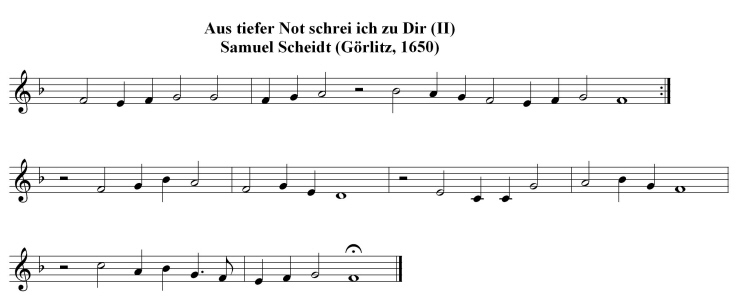
|
|
Gotha Hymnal (1715) |
|

|
| |
|
Text 2/1: Aus tiefer Not schrei ich zu dir (Psalm 130) by Martin Luther (1524) | EKG: 195 (Same text as 1/1) |
| |
|
Text 2/2: Herr, wie du willst, so schick's mit mir by Kaspar Bienemann (1582) | EKG: 285 (uses Zahn 4438 - Aus tiefer Not schrei ich zu dir {II} for Herr, wie du willst, so schicks mit mir) |
|
Kaspar Bienemann (1540-1591) was born in Nürnberg and became known as a strict Lutheran who was often embroiled in heated theological debates and, as a result, was frequently driven out of the various church offices which he had held. After 1578, he held an important position of General Supervisor in Church Matters in Altenburg, Thuringia. |
| |
|
Use of the Chorale Melodies by Bach: |
|
Melody 1: |
|
Text 1/1: Aus tiefer Not schrei ich zu dir (Psalm 130) | EKG: 195
Author: Martin Luther (1524) |
|
Ver |
Work |
Mvt. |
Year |
Br |
RE |
KE |
Di |
BC |
Score |
Music Examples |
|
1 |
BWV 38 |
Mvt. 1 |
1724 |
- |
- |
- |
- |
A152:1 |
|
Mvt. 1 (Leusink) [ram] |
|
5 |
BWV 38 |
Mvt. 6 |
1724 |
10 |
31 |
10 |
94 |
F:22
A152:6 |
PDF |
Mvt. 6 (MG) [midi] | Mvt. 6 (Leusink) [ram] |
|
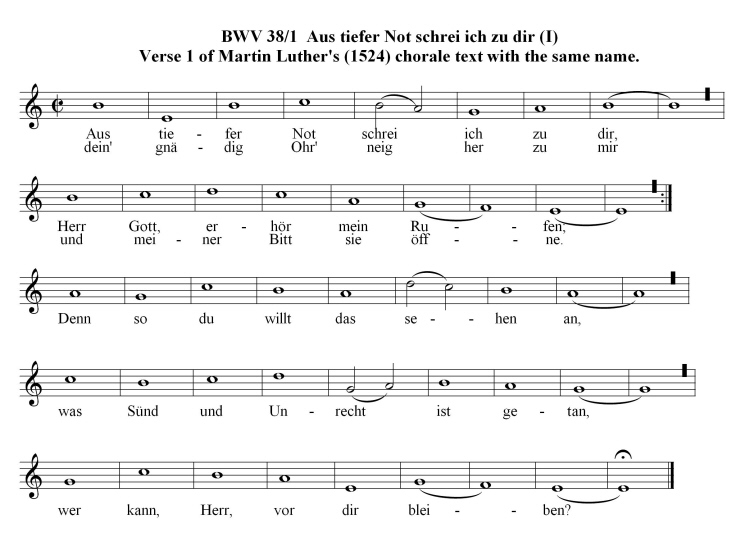
|
|

|
| |
|
Untexted: |
|
Ver |
Work |
Mvt. |
Year |
Br |
RE |
KE |
Di |
BC |
Score |
Music Examples |
|
- |
BWV 686 |
- |
1739 |
- |
- |
- |
- |
K18 |
|
|
|
- |
BWV 687 |
- |
1739 |
- |
- |
- |
- |
K19 |
|
|
|
Bach preferred the more unified forms of the central German tradition and continued to cultivate the ‘Pachelbel type’ of organ chorale in which each line of the chorale is systematically presented in imitation, usually with one voice presenting the melody as a true cantus firmus in long notes. Both the so-called large and small catechism chorales on Aus tiefer Not (BWV 686, and BWV 687), from the third part of the Clavier-Übung ( Leipzig, 1739), belong to this category.
Robert L. Marshall/Robin A. Leaver from Grove Music Online, Oxford University Press, 2005, acc. 1/23/06 |
|

|
|

|
| |
|
Melody 2: |
|
Text 2/1: Aus tiefer Not schrei ich zu dir (Psalm 130) | EKG: 195 |
|
Author: Martin Luther (1524) |
|
Ver |
Work |
Mvt. |
Year |
Br |
RE |
KE |
Di |
BC |
Score |
Music Examples |
|
- |
BWV 1099 |
- |
b1710 |
- |
- |
- |
- |
K170 |
|
|
|
BWV 1099: Chorale Prelude for organ (Neumeister Chorale No. 10) |
|
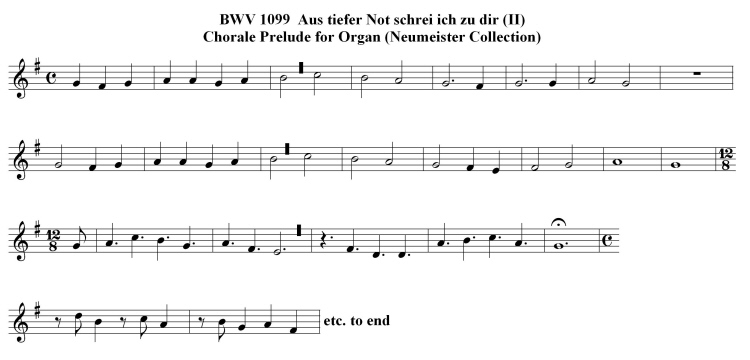
|
| |
|
Text 2/2: Herr, wie du willst, so schick's mit mir | EKG: 285 |
|
Author: Kaspar Bienemann (1582) |
|
Ver |
Work |
Mvt. |
Year |
Br |
RE |
KE |
Di |
BC |
Score |
Music Examples |
|
1 |
BWV 156 |
Mvt. 6 |
1729 |
316 |
150 |
317 |
- |
A38:6 |
PDF |
Mvt. 6 (MG) [midi] | Mvt. 6 (Leusink) [ram] |
|
- |
BWV 339 |
- |
? |
317
144 |
151 |
318 |
- |
F23.1 |
|
Chorale (MG) [midi] |
|
BWV 339: Breitkopf 317 Herr, wie du willst, so schicks mit mir; Breitkopf 144 Wer in dem Schutz des Höchsten ist = Aus tiefer Not schrei ich zu dir(II)
BWV 73/1 uses the same CT but different CM. See: Wo Gott der Herr nicht bei uns hält. |
|
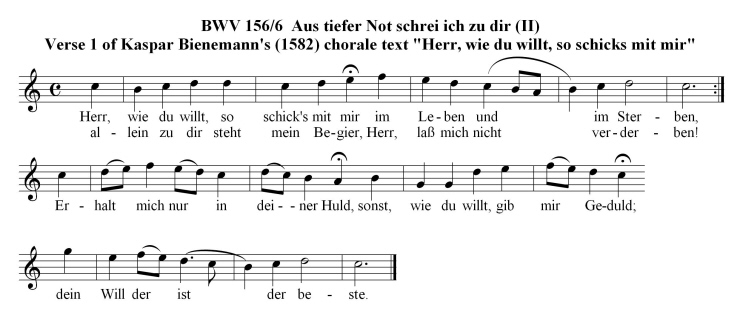
|
|
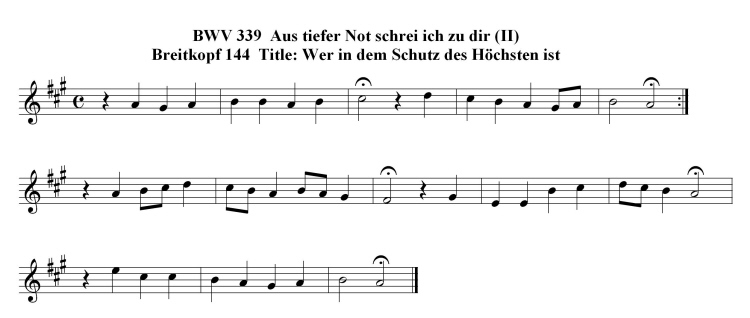
|
| |
|
Use of the Chorale Melodies by other composers: |
|
Herr wie du willst |
|
Johann Samuel Welter (1650-1720):
Cantata Herr wie du willst so schick's mit mir for 2 Sopranos, A, T, B, 2 Violins, 3 Violas, Violone, bc.-Organo. |
|
Johann Friedrich Doles, sr.(1715-1797):
Cantata Herr wie du willst |
|
Nathanael Gottfried Gruner (1732-1792):
Cantata Herr, wie du willst for Choir, 2 Horns., 2 Clarinets, 2 Bassoons |
| |
|
Aus tiefer Not |
|
Hans Kotter (c1480-1541):
The earliest extant organ setting of a Protestant chorale is an intabulation of Aus tiefer Not by the Protestant Swiss organist Hans Kotter. No other Protestant organ chorales are known from the first half of the 16th century and only isolated examples from the 1560s |
|
Sixt Dietrich (c1490-1548)
Aus tiefer Not schrei ich zu dir, Setting for 4 voices by (taken from Georg Rhau’s Newe deudsche Geistliche Gesenge, 1544) |
|
Benedictus Ducis (c1492-1544):
Settings of Aus tiefer Not, for 3 and for 4 voices |
|
Lupus [Wulfaert] Hellinck (c1494-1541):
Aus tiefer Not schrei ich zu dir, Setting for 4 Voices |
|
Arnold von Bruck (1500 (?) - 1554):
Aus tiefer Not schrei ich zu Dir, for 4 voices (1544) |
|
Melchior Franck (c1579-1639):
Aus tiefer Not schrei ich zu dir, Setting for 4 Voices
Nonetheless Franck was very expressive in his text-setting; for example, in Aus tiefer Not schrei ich zu dir when the three lower voices sing Herr Gott, erhör mein Rufen (‘Lord God, hear my call’) in a generally low tessitura the soprano enters more than an octave higher with the same words: the cry to God soars above all else. |
|
Johann Hermann Schein (1586-1630):
Aus tiefer Not schrei ich zu dir, SS, bc (1618)
Aus tiefer Not schrei ich zu dir, SATB [bc] (1627) |
|
Samuel Scheidt (1587-1654):
Aus tiefer Not schrei ich zu dir, STB, bc; SSWV 233 |
|
Johann Heinrich Scheidemann (1595-1663):
Aus tiefer Not schrei ich zu dir, Chorale Prelude for Organ |
|
Peter Morhard [Mohrhardt, Mohrhart] (?? - 1685):
Aus tiefer Not schrei ich zu dir, Chorale Prelude for Organ |
|
Christian Friedrich Witt (1660-1716):
Aus tiefer Not, Chorale Prelude for keyboard instrument |
|
Georg Böhm (1661-1733):
Chorale Partita with Variations on Aus tiefer Not schrei ich zu dir |
|
Friedrich Wilhelm Zachow (1663-1712):
Aus tiefer Not laßt uns zu Gott, Chorale Prelude [The text is different and the melody may be as well] |
Johann Christoph Oley
(1738-1789):
Aus tiefer Not schrei ich zu dir, Chorale
Prelude for Organ |
|
Siegfried Wilhelm Dehn (1799-1858):
Aus tiefer Not, Chorale Prelude for Organ |
|
Felix Mendelssohn-Bartholdy (1809-1847):
Drei Kirchenmusiken (Cantatas) (Bonn, 1832): Aus tiefer Noth, F, T, chorus, org, 19 Oct 1830; Ave Maria, A, solo vv, 8vv, bc, October 16, 1830; Mitten wir im Leben sind, c, 8vv, November 20, 1830; R xiv/B1
With few exceptions, Mendelssohn's other sacred works lie largely in the shadow of St Paul and Elijah. They include a series of Bachian chorale cantatas, composed between 1827 and 1832, of which Mendelssohn published only one, Aus tiefer Noth, in the Drei Kirchenmusiken op.23
Organ Sonata in A major, Op.65, No. 3 (1845)
The CM Aus tiefer Not schrei ich zu dir played in the pedal in the first movement
(Cantatas) (Bonn, 1832): Aus tiefer Noth, F, T, chorus, org, 19 Oct 1830; Ave Maria, A, solo vv, 8vv, bc, October 16, 1830; Mitten wir im Leben sind, c, 8vv, November 20, 1830; R xiv/B1
With few exceptions, Mendelssohn's other sacred works lie largely in the shadow of St Paul and Elijah. They include a series of Bachian chorale cantatas, composed between 1827 and 1832, of which Mendelssohn published only one, Aus tiefer Noth, in the Drei Kirchenmusiken op.23
Organ Sonata in A major, Op.65, No. 3 (1845)
The CM Aus tiefer Not schrei ich zu dir played in the pedal in the first movement
Contributed by Edmond Voeffray (April 24, 2021) |
|

|
|
Felix Mendelssohn-Bartholdy (1809-1847):
Drei Kirchenmusiken (Cantatas) (Bonn, 1832): Aus tiefer Noth, F, T, chorus, org, 19 Oct 1830; Ave Maria, A, solo vv, 8vv, bc, October 16, 1830; Mitten wir im Leben sind, c, 8vv, November 20, 1830; R xiv/B1
With few exceptions, Mendelssohn's other sacred works lie largely in the shadow of St Paul and Elijah. They include a series of Bachian chorale cantatas, composed between 1827 and 1832, of which Mendelssohn published only one, Aus tiefer Noth, in the Drei Kirchenmusiken op.23 |
|
Franz Liszt (1811-1886):
Aus tiefer Noth schrei ich zu dir [based on Bach, BWV 38], org/hmn/pedal pf (1856-1860) |
|
Albert (Ernst Anton) Becker (1834-1899):
Aus tiefer Not (Phrygian) contained in the Reformations-Cantate Op. 28 for soloists, choir, orchestra and organ (1883) |
|
Theophil Forchhammer (1847-1923):
Fantasie and Choral Aus tiefer Not schrei ich zu dir for Organ with Mixed Chorus ad lib, Op. 12 (Leipzig, 1886) |
|
Arnold Ludwig Mendelssohn (1855-1933):
Chorale Cantata Aus tiefer Not, Op. 54 (Leipzig, 1912) |
|
Hugo Kaun (1863-1932):
Aus tiefer Not, Choral Prelude for Organ (Berlin, 1911) |
|
Fidelio Fritz Finke (1891-1968):
Fantasie, Variationen und Doppelfuge on Aus tiefer Not (1928) |
|
Willy Burkhard (1900-1955):
Variations on Aus tiefer Not for Organ, Op. 28
Variationen on the Hassler Chorale Setting of Aus tiefer Not |
|
Robert Blum (1900-1994):
Variationen on Aus tiefer Not, for orchestra (1952) |
|
Henk Badings (1907-1987):
Aus tiefer Not, Chorale Prelude for Organ (1978) |
|
Jürg Baur (1918-2003):
Aus tiefer Not, Chorale Partita for Organ (1965) |
|
Jan Maegaard (b 1926):
Aus tiefer Not, Chorale Prelude for Organ, op. 47 (1966) |
|
Philippe Hersant (b 1948):
Aus tiefer Not (Ps cxxx), chorus, va da gamba, positive org (1994) |
| |
|
Sources: NBA, vols. III/2.1 & 2.2 in particular [Bärenreiter, 1954 to present] and the BWV ("Bach Werke Verzeichnis") [Breitkopf & Härtel, 1998]
The PDF files of the Chorales were contributed by Margaret Greentree J.S. Bach Chorales
Software: Capella 2004 Software, version 5.1.
Prepared by Thomas Braatz & Aryeh Oron (January 2006 - April 2021)
Thanks to contributors: Edmond Voeffray (April 2021) |